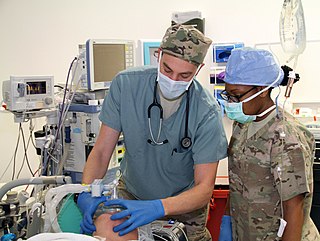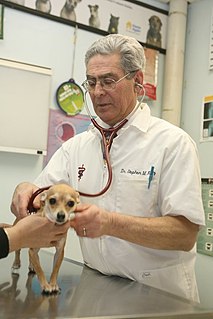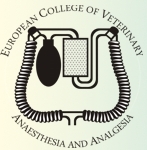Related Research Articles

Anesthesiology, anaesthesiology, or anaesthesia is the medical specialty concerned with the total perioperative care of patients before, during and after surgery. It encompasses anesthesia, intensive care medicine, critical emergency medicine, and pain medicine. A physician specialized in anesthesiology is called an anesthesiologist, anaesthesiologist, or anaesthetist, depending on the country. In some countries, the terms are synonymous, while in other countries they refer to different positions and anesthetist is only used for non-physicians, such as nurse anesthetists.

The American Veterinary Medical Association (AVMA), founded in 1863, is a not-for-profit association representing more than 99,500 veterinarians in the US.

Oral and maxillofacial surgery is a surgical specialty focusing on reconstructive surgery of the face, facial trauma surgery, the oral cavity, head and neck, mouth, and jaws, as well as facial cosmetic surgery/facial plastic surgery including cleft lip and cleft palate surgery.
A veterinary specialist is a veterinarian who specializes in a clinical field of veterinary medicine.
Zoological medicine refers to the specialty of veterinary medicine that addresses the care of captive zoo animals, free ranging wildlife species, aquatic animals, birds, reptiles and amphibians, and includes non-domestic companion animals. Zoological medicine incorporates principles of ecology, wildlife conservation, and veterinary medicine, and applies them to wild animals in natural and artificial environments. As a specialty of veterinary medicine in the United States, the American Veterinary Medical Association (AVMA) has recognized the College of Zoological Medicine as the governing body of this specialty field since 1983. As such, zoological medicine is equivalent to other subspecialties of veterinary medicine, which are recognized and governed by their particular colleges.
The Association of Veterinary Anaesthetists (AVA) are a group of people who promote the usage, research, and study of anaesthesia in veterinary medicine.
In the United States, anesthesia can be administered by physician anesthesiologists, an anesthesiologist assistant, or nurse anesthetist.
Veterinary anesthesia is anesthesia performed on non-human animals by a veterinarian or a Registered Veterinary Technician. Anesthesia is used for a wider range of circumstances in animals than in people, due to animals' inability to cooperate with certain diagnostic or therapeutic procedures. Veterinary anesthesia includes anesthesia of the major species: dogs, cats, horses, cattle, sheep, goats, and pigs, as well as all other animals requiring veterinary care such as birds, pocket pets, and wildlife.
Harold Randall Griffith was a Canadian anesthesiologist and a leader in the fields of anesthesiology.
Cardiothoracic anesthesiology is a subspeciality of the medical practice of anesthesiology, devoted to the preoperative, intraoperative, and postoperative care of adult and pediatric patients undergoing cardiothoracic surgery and related invasive procedures.
Neurosurgical anesthesiology, neuroanesthesiology, or neurological anesthesiology is a subspecialty of anesthesiology devoted to the total perioperative care of patients before, during, and after neurological surgeries, including surgeries of the central (CNS) and peripheral nervous systems (PNS). The field has undergone extensive development since the 1960s correlating with the ability to measure intracranial pressure (ICP), cerebral blood flow (CBF), and cerebral metabolic rate (CMR).

Paraveterinary worker is the professional of veterinary science that performs procedures autonomously or semi autonomously, as part of a veterinary assistance system. The job role varies throughout the world, and common titles include veterinary nurse, veterinary technician and veterinary assistant, and variants with the prefix of 'animal health'.

The American College of Veterinary Surgeons (ACVS) is the specialty board that defines the standards of surgical excellence for the field of veterinary medicine, promotes advancements in veterinary surgery, and provides the latest in veterinary surgical educational programs. The ACVS is responsible for overseeing the training, examination, and certification of board-certified veterinary surgeons.

Veterinary medicine in the United States is the performance of veterinary medicine in the United States, normally performed by licensed professionals, and subject to provisions of statute law which vary by state. Veterinary medicine is normally led by veterinary physicians, termed veterinarians or vets.
In the United States, certified anesthesiologist assistants (CAAs) are clinicians that practice medicine under the direction of licensed anesthesiologists to implement anesthesia care plans for a patient undergoing surgery. CAAs are integral members of the anesthesia care team as described by the American Society of Anesthesiologists (ASA). All CAAs possess a baccalaureate degree, and complete an intensive didactic and clinical program at a postgraduate level. CAAs are trained in the delivery and maintenance of all types of anesthesia care as well as advanced patient monitoring techniques. The goal of CAA education is to guide the transformation of student applicants into competent clinicians.
The following outline is provided as an overview of and topical guide to anesthesia:

The American Osteopathic Board of Anesthesiology (AOBA) is an organization that provides board certification to qualified Doctors of Osteopathic Medicine (D.O.) who specialize in the administration of anesthetic agents and perioperative medicine (anesthesiologists). The board is one 16 medical specialty certifying boards of the American Osteopathic Association Bureau of Osteopathic Specialists approved by the American Osteopathic Association (AOA), and was established in 1956. As of October 2019, 720 osteopathic anesthesiologists held active certification with the AOBA. Currently 85 Diplomates have subspecialty certification in Pain Management, 13 in Critical Care Medicine, and 20 in Pediatric Anesthesiology.

The European College of Veterinary Anaesthesia and Analgesia (ECVAA) is one of 25 veterinary specialist colleges recognized by the European Board of Veterinary Specialisation, comprising more than 35 distinct specialties.
Obstetric anesthesia or obstetric anesthesiology, also known as ob-gyn anesthesia or ob-gyn anesthesiology, is a sub-specialty of anesthesiology that provides peripartum pain relief (analgesia) for labor and anesthesia for cesarean deliveries ('C-sections').
Gertie Florentine Marx (1912-2004) was an obstetric anesthesiologist, "internationally known as 'the mother of obstetric anaesthesia'". Marx pioneered the use of epidural analgesia during childbirth, and was the founding editor of the quarterly Obstetric Anesthesia Digest.
References
- ↑ "Veterinary specialties". American Veterinary Medical Association . Retrieved August 22, 2021.
- ↑ Short, Charles; Soma, Lawrence (June 2020). "Beginnings of a Specialty: the Creation of the American College of Veterinary Anesthesia". Veterinary Heritage. 43 (1): 32–37.
- 1 2 Thurmon, John; Short, Charles (2007). "History and Overview of Veterinary Anesthesia". Lumb & Jones' Veterinary Anesthesia and Analgesia (4th ed.). Blackwell Publishing. p. 4. ISBN 978-0-7817-5471-2.
- ↑ "About the ACVAA". American College of Veterinary Anesthesia and Analgesia. Retrieved 1 August 2021.
- ↑ "Veterinary specialists 2020". American Veterinary Medical Association . Retrieved August 23, 2021.
- ↑ "Guidelines and Position Statements". American College of Veterinary Anesthesia and Analgesia. ACVAA. Retrieved 1 August 2021.